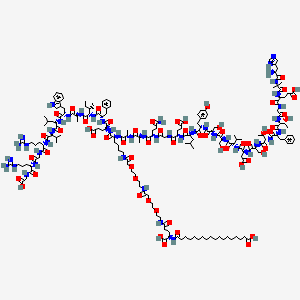Semaglutide
Weight management in obesity
Cardiovascular risk reduction
Potential neuroprotective effects
Semaglutide is a synthetic glucagon-like peptide-1 (GLP-1) receptor agonist used to manage type 2 diabetes and obesity. It mimics the action of the natural incretin hormone GLP-1, enhancing insulin secretion, suppressing glucagon release, and promoting satiety.
Mechanism of action
Semaglutide binds to GLP-1 receptors, stimulating insulin secretion and inhibiting glucagon release in a glucose-dependent manner. It slows gastric emptying and reduces appetite, leading to decreased food intake. Structural modifications confer resistance to enzymatic degradation, allowing for once-weekly dosing.
Notable Studies
The STEP 1 trial demonstrated significant weight loss in overweight and obese individuals using semaglutide.
The SUSTAIN 6 trial showed cardiovascular risk reduction in type 2 diabetes patients treated with semaglutide.
Risk Associated
Gastrointestinal issues: nausea, vomiting, diarrhea
Risk of pancreatitis
Potential thyroid C-cell tumors (observed in rodents)
Hypoglycemia when combined with other antidiabetic agents
Dosage
For type 2 diabetes (Ozempic): Start at 0.25 mg weekly, increasing to 0.5 mg or 1 mg as needed.
For obesity (Wegovy): Start at 0.25 mg weekly, increasing weekly by 0.25 mg to a maximum of 2.4 mg weekly.
External link


Semaglutide
Weight management in obesity
Cardiovascular risk reduction
Potential neuroprotective effects
Mechanism of action
Semaglutide binds to GLP-1 receptors, stimulating insulin secretion and inhibiting glucagon release in a glucose-dependent manner. It slows gastric emptying and reduces appetite, leading to decreased food intake. Structural modifications confer resistance to enzymatic degradation, allowing for once-weekly dosing.
Risk
Associated
Gastrointestinal issues: nausea, vomiting, diarrhea
Risk of pancreatitis
Potential thyroid C-cell tumors (observed in rodents)
Hypoglycemia when combined with other antidiabetic agents
Notable Studies
The STEP 1 trial demonstrated significant weight loss in overweight and obese individuals using semaglutide.
The SUSTAIN 6 trial showed cardiovascular risk reduction in type 2 diabetes patients treated with semaglutide.
Dosage
For type 2 diabetes (Ozempic): Start at 0.25 mg weekly, increasing to 0.5 mg or 1 mg as needed.
For obesity (Wegovy): Start at 0.25 mg weekly, increasing weekly by 0.25 mg to a maximum of 2.4 mg weekly.
External link
Semaglutide
Weight management in obesity
Cardiovascular risk reduction
Potential neuroprotective effects
Mechanism of action
Semaglutide binds to GLP-1 receptors, stimulating insulin secretion and inhibiting glucagon release in a glucose-dependent manner. It slows gastric emptying and reduces appetite, leading to decreased food intake. Structural modifications confer resistance to enzymatic degradation, allowing for once-weekly dosing.

Risk
Associated
Gastrointestinal issues: nausea, vomiting, diarrhea
Risk of pancreatitis
Potential thyroid C-cell tumors (observed in rodents)
Hypoglycemia when combined with other antidiabetic agents
Notable Studies
The STEP 1 trial demonstrated significant weight loss in overweight and obese individuals using semaglutide.
The SUSTAIN 6 trial showed cardiovascular risk reduction in type 2 diabetes patients treated with semaglutide.
Dosage
For type 2 diabetes (Ozempic): Start at 0.25 mg weekly, increasing to 0.5 mg or 1 mg as needed.
For obesity (Wegovy): Start at 0.25 mg weekly, increasing weekly by 0.25 mg to a maximum of 2.4 mg weekly.
External link
-
StatPearls – Semaglutide Overview
-
DrugBank – Semaglutide Details
-
Drugs.com – Semaglutide Information
-
Wikipedia – Semaglutide
-
Ozempic – Mechanism of Action
-
JAMA Network – Weight Loss Outcomes with Semaglutide